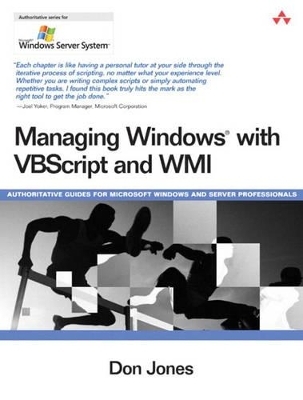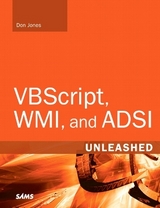
Managing Windows with VBScript and WMI
Addison-Wesley Educational Publishers Inc
978-0-321-21334-1 (ISBN)
- Titel erscheint in neuer Auflage
- Artikel merken
"Finally, a step-by-step VBScripting book to make you look like a programmer without the time and sweat! Don't waste your time searching the Internet for examples--this book does it for you!"
--Greg A. Marino, Senior Systems Engineer/Consultant, Westtown Consulting Group, Inc.
Visual Basic Scripting (VBScript) and Windows Management Instrumentation (WMI) are vital tools for systems administrators grappling with the increasing complexity of Windows technologies. However, busy admins have been without a straightforward guide to scripting...until now.
Managing Windows® with VBScript and WMI explains how Windows administrators can effectively use VBScript to automate common administrative tasks and simplify complex ones. Detailed coverage of security concerns provides admins with the means for safely using VBScript in Windows environments. The book is organized around the problems you face daily, with reusable examples and coverage of Windows NT, Windows 2000, Windows XP, and Windows 2003.
This user-friendly reference demystifies scripting and then shows you how to produce new scripts from scratch. You will be producing useful scripts right away as you study the VBScript language and learn how to control nearly every aspect of the Windows operating system with WMI and the Active Directory Services Interface (ASDI). You will be able to build your own administrative Web pages and use advanced scripting technologies such as script encryption, scripting components, and script security. The book closes with still more ready-made example scripts accompanied by complete line-by-line explanations. The CD includes all the code from the book and trial versions of PrimalScript 3.0 and VbsEdit. A companion Web site provides updates and errata.
Inside you will find answers to such questions as:
How do you write effective logon scripts? Chapter 11
How do you write scripts that query and modify user and group information? Chapter 16
How can you query the IP addresses from multiple network adapters in multiple remote computers? Chapter 19
How can you design, write, run, test, and debug your own administrative Web pages? Chapter 24
How can you reuse code between various scripts? Chapter 25
Don Jones, MCSE, CTT+, is an independent consultant and founding partner of BrainCore.Net, the world leader in exam development and delivery technologies for the information technology industry. Don is the author of more than a dozen books and the creator and series editor of Sams Publishing's Delta Guide series, helping experienced administrators quickly get up to speed on Microsoft server technologies. Don is also a contributing editor and columnist for Microsoft® Certified Professional Magazine, the Microsoft technology columnist for CertCities.com, and a speaker at technology conferences.
Preface xxi
Acknowledgments xxxv
About the Author xxxvii
PART I--INTRODUCTION TO WINDOWS ADMINISTRATIVE SCRIPTING 1Chapter 1 Scripting Concepts and Terminology 3What Is Scripting? 3 Script Hosts 4 ActiveX Scripting Languages 6 The Component Object Model (COM) 9 Critical Scripting Security Issues 9 Review 10Chapter 2 Running Scripts 11Windows Script Host 11 Command-Line Scripts 13 Notepad and Script Editors 16 Bare Bones: Notepad 16 A Step Up: Programmer's File Editor 17 Script-Specific: VBScript Editors 18 Writing Your First Script 23 Running Your First Script 25 Debugging Your First Script 25 Review 26 Chapter 3 The Components of a Script 29A Typical VBScript 29 Functions 32 Subroutines 33 Main Script 34 Using Custom Functions and Subroutines 36 Using Intrinsic Functions and Statements 38 Making Decisions in a Script 40 Comments and Documentation 40 Review 45Chapter 4 Designing a Script 47Creating a Task List 48 Selecting the Appropriate Tools 50 Displaying a Message 51 Mapping a Drive 53 Checking Group Membership 54 Mapping a Printer 54 Getting the Local IP Address 54 Getting the Third Octet from the IP Address 56 All Tasks Accounted For 56 Creating Modules to Perform Tasks 57 Validating User Input 63 Planning for Errors 63 Creating Script Libraries 66 Review 66PART II--VBSCRIPT TUTORIAL 69Chapter 5 Functions, Objects, Variables, and More 71What Are Variables? 72 Declaring Variables 76 Understanding Data Types 78 Assigning Data to Variables 79 Data Coercion 80 What Are Functions? 82 Input Parameters 82 Output Values 84 Intrinsic versus Custom Functions 85 What Are Statements and Subroutines? 89 Functions, without the Output 89 What Are Objects? 92 Properties 92 Methods 93 Collections 93 A Sample Object 94 Scripting with Objects 95 Review 97Chapter 6 Input and Output 99Displaying Messages 99 The MsgBox Statement and Function 100 More Complex Messages 104 MsgBox Best Practices 105 Go Generic with WScript.Echo 106 Asking for Input 107 Graphical Input 107 Command-Line Input 109 Command-Line Parameters as Input 110 Running Command-Line Scripts 110 Parsing Parameters 110 Review 114Chapter 7 Manipulating Numbers 117Numbers in VBScript 117 Basic Arithmetic 118 Advanced Arithmetic 121 Boolean Math 124 Converting Numeric Data Types 129 Converting Other Data Types to Numeric Data 130 Review 130Chapter 8 Manipulating Strings 133Strings in VBScript 133 Working with Substrings 135 Concatenating Strings 139 Changing Strings 141 Formatting Strings 143 Converting Other Data Types to String Data 144 Review 145Chapter 9 Manipulating Other Types of Data 147Working with Dates and Times 147 Dates and Times in VBScript 148 Getting the Date or Time 148 Converting Date and Time Data 149 Working with Past and Future Dates 150 Working with Arrays 150 Arrays in VBScript 151 Creating and Manipulating Arrays 152 Working with Array Data 154 Working with Bytes 155 Bytes in VBScript 155 Converting Byte Data 156 Review 156Chapter 10 Controlling the Flow of Execution 157Conditional Execution 158 If...Then 158 Select...Case 163 Loops 164 Do While...Loop and Do...Loop While 164 Do Until...Loop and Do...Loop Until 166 For...Next 166 For Each...Next 167 Exiting Loops 169 Putting It All Together 170 Review 173Chapter 11 Built-in Scripting Objects 175The WScript Object 175 The Network Object 176 Overview 177 Methods and Properties 177 Practical Application 182 The Shell Object 183 Overview 183 Methods and Properties 183 The Shortcut Object 190 Methods and Properties 190 Practical Application 191 Review 192Chapter 12 Working with the File System 193The FileSystemObject Library 193 Working with Drives 194 Working with Drive Objects 195 Working with Folders 197 Working with Folder Objects 198 Folder Attributes 200 Properties That Are Objects 203 Working with Files 204 Working with File Objects 204 Reading and Writing Text Files 207 Other FSO Methods and Properties 211 Creating a Log File Scanner 212 Review 221Chapter 13 Putting It All Together: Your First Script 223Designing the Script 224 Gathering Facts 224 Defining Tasks 225 Outlining the Script 226 Writing Functions and Subroutines 227 Identifying Candidate Modules 227 Writing the Filename Formatting Function 227 Writing the Main Script 232 Identifying Potential Errors 237 Testing the Script 240 Analyzing the Results 242 Adding Debug Code 243 Modifying the Script 246 Completing the Script 248 Review 251PART III--WINDOWS MANAGEMENT INSTRUMENTATION AND ACTIVE DIRECTORY SERVICES INTERFACE 253Chapter 14 Working with ADSI Providers 255Using ADSI Objects 255 Using the WinNT Provider 257 Examples 259 Using the LDAP Provider 260 Other Providers 263 Review 263Chapter 15 Manipulating Domains 265Querying Domain Information 265 Changing Domain Settings 267 Working with OUs 268 Creating an OU 268 Modifying an OU 270 Querying an OU 272 Deleting an OU 272 Putting It All Together 273 Review 279Chapter 16 Manipulating Users and Groups 281Creating Users and Groups 281 The WinNT Way 282 The LDAP Way 283 Querying User Information 284 Changing User Settings 285 Working with Groups 286 Putting It All Together 288 Review 292Chapter 17 Understanding WMI 293The WMI Hierarchy 293 Providers and Consumers 295 WMI Versions 296 Exploring WMI's Capabilities 296 WQL Queries 300 Installing WMI 301 Using the WMI Tools 302 Scriptomatic 304 Really--It's This Easy 304 Find the Class 304 Write the Query, Test the Query 306 Write the Script 307 Try the Script 309 Review 309Chapter 18 Querying Basic WMI Information 311The WMI Query Language (WQL) 311 The Basics 313 Boolean Operators 314 Comparison Operators 314 Associators, References, and Keys 316 Determining What to Query 316 Testing the Query 319 Writing the Query in VBScript 321 Using the Query Results 326 Alternative Methods 328 Review 329Chapter 19 Querying Complex WMI Information 331Understanding WMI Relationships 331 Associating WMI Instances 336 ASSOCIATORS OF 336 REFERENCES OF 338 Using WHERE with ASSOCIATIONS OF and REFERENCES OF 339 Writing the Query 340 Testing the Query 341 Writing the Query in VBScript 341 Another Example 345 Review 349Chapter 20 Putting It All Together: Your First WMI/ADSI Script 351Designing the Script 351 Writing Functions and Subroutines 357 Writing the Main Script 360 Testing the Script 369 Review 374PART IV--CREATING ADMINISTRATIVE WEB PAGES 375Chapter 21 Active Server Pages Crash Course 377About ASP 378 VBScript in ASP 379 The Response Object 381 Writing Output 382 Saving Cookies 382 Ending 384 The Request Object 384 HTML Forms 384 Cookies 385 A Sample ASP Script 385 Testing ASP Scripts 389 Review 391Chapter 22 Adding Administrative Script to a Web Page 393The Basic Web Page 393 Adding Functions and Subroutines 396 Adding Inline Script 397 The Result 403 Review 417Chapter 23 Web Page Security Overview 419The ASP Security Context 419 Prohibited Behaviors 423 IIS 4.0, 5.0, and 5.1 versus IIS 6.0 424 NTFS and IIS Security 427 Writing Secure ASP Code 427 Review 431Chapter 24 Putting It All Together: Your First Administrative Web Pages 433Checking User Account Status 433 Designing the Page 434 Writing Functions and Subroutines 435 Writing the Main Script 437 Testing the Page 442 Administering IIS 443 Designing the Page 443 Writing Functions and Subroutines 444 Writing the Main Script 449 Review 460PART V--ADVANCED SCRIPTING TECHNIQUES 461Chapter 25 Modular Script Programming 463Introduction to Windows Script Components 463 Scripting and XML 465 Review 474Chapter 26 Using Script Components 475Obtaining the Component 475 Reviewing the Component 476 Using the Component 477 Review 479Chapter 27 Encoded Scripts 481Installing the Script Encoder 482 Writing Encoded Scripts 482 Running Encoded Scripts 485 Review 486Chapter 28 Scripting Security 487Why Scripting Can Be Dangerous 487 Security Improvements in Windows XP and Windows Server 2003 488 Digitally Signing Scripts 490 Running Only Signed Scripts 493 Ways to Implement Safe Scripting 494 The Filename Extension Game 494 Script Signing 494 Antivirus Software 494 Defunct Techniques 495 Review 495PART VI--READY-TO-RUN EXAMPLES 497Chapter 29 Logon and Logoff Scripts 499NT and Active Directory Logon Scripts 500 Active Directory-Specific Logon Scripts 507 Active Directory Logoff Scripts 513 Review 516Chapter 30 Windows and Domain Administration Scripts 517Automating User Creation 517 Finding Inactive Users 527 Collecting System Information 533 Review 539Chapter 31 Network Administration Scripts 541Shutting Down Remote Computers 541 Listing Remote Shares 544 Finding Out Who Has a File Open 547 Uninstall Remote MSI Packages 549 Adding Users from Excel 553 Listing Hot Fixes and Software 562 Review 566Chapter 32 WMI and ADSI Scripts 567The All-Purpose WMI Query Script 567 The All-Purpose WMI Update Script 569 The All-Purpose ADSI Object Creation Script 571 The All-Purpose ADSI Object Query Script 572 The All-Purpose ADSI Object Deletion Script 573 Mass Password Changes with ADSI 574 Review 576PART VII--APPENDIX 577Appendix Administrator's Quick Script Reference 579Index 591
| Erscheint lt. Verlag | 7.4.2004 |
|---|---|
| Verlagsort | New Jersey |
| Sprache | englisch |
| Maße | 235 x 178 mm |
| Gewicht | 907 g |
| Themenwelt | Informatik ► Betriebssysteme / Server ► Windows |
| ISBN-10 | 0-321-21334-3 / 0321213343 |
| ISBN-13 | 978-0-321-21334-1 / 9780321213341 |
| Zustand | Neuware |
| Haben Sie eine Frage zum Produkt? |
